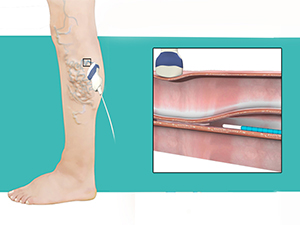Get Rid of Varicose Veins With the Help Of VenaSeal
The Process
We perform the VenaSeal procedure at our clinic. Your surgeon will position the device inside the diseased vein through a small incision with guidance from an ultrasound. It delivers medical glue along the length of the vein, effectively closing the diseased blood vessel and preventing varicose veins. After the procedure, your varicose veins will significantly decrease in size or completely disappear.
A simple bandage is then placed over the insertion site and additional compression is provided to aid healing. Patients who undergo treatment typically resume normal activities within a day.
VenaSeal Procedure FAQs
Unlike endovenous laser treatments (EVLT), VenaSeal uses medical glue to seal the diseased vein. It avoids the multiple needles needed to deliver local anesthetic for EVLT treatments.
Since a longer segment of the diseased vein can be treated, it also reduces the need to undergo other procedures in the future. Other advantages include:
-
Decreased Pain and Discomfort During the Treatment
-
Faster Recovery
- Increased Long-Term Durability Compared to Laser
-
Multiple Diseased Veins Can Be Treated During One Procedure
With vein stripping, the physician makes an incision in your groin and ties off the blood vessel. A tool is then threaded through the leg vein to pull it out through a second incision near your knee.
Most diseased veins can be treated with minimally invasive methods, and avoid vein stripping. Unfortunately most surgeons do not have the necessary training or expertise for minimal invasive vein procedures. Subsequently, only vein stripping may be offered to patients. Before proceeding with vein stripping, it is important to ask your surgeon if they perform any minimal invasive vein procedures, and why only vein stripping may have been offered.
When you undergo the VenaSeal procedure, you can avoid the following:
-
General Anesthesia and Intubation
-
Multiple Incisions and Scars Along Your Leg
-
Possible Narcotics Needed for Pain Control
-
Two to Four Weeks of Recovery
Ontario Health Insurance Plan (OHIP) does not cover VenaSeal. However, some private companies may cover the cost. Contact your insurance provider to determine if your plan includes this treatment.
You may apply for financing by Medicard through our website today. Please visit Patient Financing page.
The VenaSeal procedure typically takes one hour.
It is performed under local anesthesia that is usually injected in one spot. Unlike EVLT or Venefit, you do not receive multiple needle sticks to deliver local anesthetic over the vein.
The procedure is performed at our Kitchener location.
Most patients perform their usual activities within one to two days. For a few weeks following the treatment, we recommend a regular walking regimen and suggest that you refrain from strenuous activities (i.e., heavy lifting) or prolonged periods of standing. We also recommend that you wear your compression stockings for the first two weeks after surgery.
Patients report a noticeable improvement in their symptoms within one to two weeks following the procedure.
Although it is possible to experience pain, bruising, or tenderness, many patients report minimal to no scarring or swelling following the treatment.
Results depend on the severity of your varicose veins. Expect the appearance of your legs to improve after the procedure. You may also feel immediate relief from the painful signs and symptoms you are experiencing.
As with any medical intervention, potential risks and complications exist alongside your procedure. Your surgeon will have a consultation with you to determine if your conditions present any special risks.
They will also review with you potential complications associated with the VenaSeal procedure, which may include:
-
Hematoma
-
Infection
-
Paresthesia (Numbness or Tingling)
-
Phlebitis
-
Pulmonary Embolism
-
Skin Discolouration
-
Thrombosis
-
Vessel Perforation
During your consultation, your surgeon will discuss whether your varicose veins are suitable for the VenaSeal procedure. We assure you that many patients who are experiencing this condition as well as chronic venous insufficiency can be treated.
The most important step in determining whether the procedure is appropriate for you is a complete ultrasound examination done by your vascular surgeon. Age alone is not a factor in determining if it is right for you. This procedure has been used to treat both women and men who have a wide range of ages.
After treatment, the affected vein becomes fibrous tissue. Over time, it will be absorbed into the surrounding tissue and blood will be rerouted to other blood vessels.

